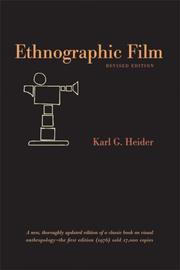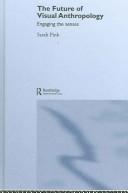| Listing 1 - 5 of 5 |
Sort by
|

ISBN: 0691121559 0691121567 1400831563 1299973493 9780691121550 9780691121567 9781400831562 Year: 2006 Publisher: Princeton, N.J. Princeton University Press
Abstract | Keywords | Export | Availability | Bookmark
 Loading...
Loading...Choose an application
- Reference Manager
- EndNote
- RefWorks (Direct export to RefWorks)
In this book, David MacDougall, one of the leading ethnographic filmmakers and film scholars of his generation, builds upon the ideas from his widely praised Transcultural Cinema and argues for a new conception of how visual images create human knowledge in a world in which the value of seeing has often been eclipsed by words. In ten chapters, MacDougall explores the relations between photographic images and the human body-the body of the viewer and the body behind the camera as well as the body as seen in ethnography, cinema, and photography. In a landmark piece, he discusses the need for a new field of social aesthetics, further elaborated in his reflections on filming at an elite boys' school in northern India. The theme of the school is taken up as well in his discussion of fiction and nonfiction films of childhood. The book's final section presents a radical view of the history of visual anthropology as a maverick anthropological practice that was always at odds with the anthropology of words. In place of the conventional wisdom, he proposes a new set of principles for visual anthropology. These are essays in the classical sense--speculative, judicious, lucidly written, and mercifully jargon-free. The Corporeal Image presents the latest ideas from one of our foremost thinkers on the role of vision and visual representation in contemporary social thought.
Visual anthropology. --- Photography in ethnology. --- Motion pictures in ethnology. --- Moving-pictures in ethnology --- Photography in ethnology --- Social & Cultural Anthropology --- Visual anthropology --- Ethnology --- Film --- Photography --- Ethnology. Cultural anthropology --- Semiotics
Book
ISBN: 2843031265 9782843031267 Year: 2006 Publisher: Paris La Dispute
Abstract | Keywords | Export | Availability | Bookmark
 Loading...
Loading...Choose an application
- Reference Manager
- EndNote
- RefWorks (Direct export to RefWorks)
Ce livre traite de la magie du spectacle. Le spectacle et sa séduction sont souvent considérés avec mépris (ils ne seraient pas dignes de l'art) ou avec effroi (telle la télévision, qui aurait la faculté de faire de nos enfants des criminels). S'y attacher serait à la fois faire preuve d'inconsistance intellectuelle et contribuer au retour de la barbarie. La démarche anthropologique consiste, plus sérieusement, à étudier la manière dont le spectateur peut prendre plaisir au spectacle. En imposant à l'observateur de se prendre lui-même comme objet, de s'inclure dans l'observation, elle permet de donner toute leur importance à la compétence artistique du spectateur, à sa sensibilité personnelle et à son sens de la responsabilité, à son attention aux choses et aux personnes que le spectacle touche. Adopter le point de vue de ce spectateur compétent, qui sait contrôler le plaisir du spectacle, et le transmettre à autrui, c'est rappeler la manière dont les techniques artistiques - la peinture, le théâtre, la danse, l'opéra, le roman, etc. - constituent d'abord des techniques du corps pour l'individu qui y trouve le moyen de cultiver un plaisir artistique, et la force du lien social éphémère que ces techniques permettent de nouer avec autrui. Ce livre entend ainsi contribuer à la reconnaissance du savoir ordinaire du spectacle - de l'industrie du fantôme au feuilleton gay, de l'estampe japonaise au mélodrame du Boulevard, de l'art contemporain à la comédie musicale, de la star au figurant, du corps idéalisé au corps stigmatisé - et à la manière dont il peut servir au développement d'une commune humanité.
Television play --- Ethnology. Cultural anthropology --- Visual anthropology. --- Spectacular, The. --- Amusements --- Performing arts --- Anthropologie visuelle --- Spectaculaire --- Spectacles et divertissements --- Arts du spectacle --- Social aspects --- Audiences --- Aspect social --- Publics
Book
ISBN: 9782742763900 2915133336 2742763902 Year: 2006 Publisher: Paris Musée du quai Branly, Actes Sud
Abstract | Keywords | Export | Availability | Bookmark
 Loading...
Loading...Choose an application
- Reference Manager
- EndNote
- RefWorks (Direct export to RefWorks)
musée du quai Branly (Parijs) --- fotografie --- exotisme --- etnografie --- 19de eeuw --- Exhibitions --- Photography in ethnology --- Photography --- History --- Visual anthropology --- musée du quai Branly (Parijs). --- exotisme. --- etnografie. --- 19de eeuw.

ISBN: 0292714580 9780292714588 9780292714588 0292795653 Year: 2006 Publisher: Austin : University of Texas Press,
Abstract | Keywords | Export | Availability | Bookmark
 Loading...
Loading...Choose an application
- Reference Manager
- EndNote
- RefWorks (Direct export to RefWorks)
Even before Robert Flaherty released Nanook of the North in 1922, anthropologists were producing films about the lifeways of native peoples for a public audience, as well as for research and teaching. Ethnographic Film (1976) was one of the first books to provide a comprehensive introduction to this field of visual anthropology, and it quickly became the standard reference. In this new edition, Karl G. Heider thoroughly updates Ethnographic Film to reflect developments in the field over the three decades since its publication, focusing on the work of four seminal filmmakers—Jean Rouch, John Marshall, Robert Gardner, and Timothy Asch. He begins with an introduction to ethnographic film and a history of the medium. He then considers many attributes of ethnographic film, including the crucial need to present "whole acts," "whole bodies," "whole interactions," and "whole people" to preserve the integrity of the cultural context. Heider also discusses numerous aspects of making ethnographic films, from ethics and finances to technical considerations such as film versus video and preserving the filmed record. He concludes with a look at using ethnographic film in teaching.

ISBN: 9780415357647 9780415357654 0415357659 0415357640 0203003594 9780203003596 9781134247097 9781134247134 9781134247141 Year: 2006 Publisher: New York, N.Y. Routledge
Abstract | Keywords | Export | Availability | Bookmark
 Loading...
Loading...Choose an application
- Reference Manager
- EndNote
- RefWorks (Direct export to RefWorks)
From an eminent author in the field, 'The Future of Visual Anthropology' develops a new approach to visual anthropology and presents a groundbreaking examination of developments within the field and the way forward for the subdiscipline in the twenty-first century The explosion of visual media in recent years has generated a wide range of visual and digital technologies which have transformed visual research and analysis. The result is an exciting new interdisciplinary approach of great potential influence for the future of social/cultural anthropology. Sarah Pink argues that this potential can be harnessed by engaging visual anthropology with its wider contexts, including: * the increasing use of visual research methods across the social sciences and humanities * the growth in popularity of the visual as methodology and object of analysis within mainstream anthropology and applied anthropology * the growing interest in 'anthropology of the senses' and media anthropology * the development of new visual technologies that allow anthropologists to work in new ways. This book has immense interdisciplinary potential, and will be essential reading for students, researchers and practitioners of visual anthropology, media anthropology, visual cultural studies, media studies and sociology.
Ethnology. Cultural anthropology --- Mass communications --- Qualitative methods in social research --- Semiotics --- #SBIB:39A8 --- #SBIB:39A2 --- mediatheorie --- 39 --- 791.5 --- 7.01 --- 130.2 --- 766.022 --- lichamelijkheid --- zintuiglijkheid --- sociologie --- cultuurfilosofie --- informatiedesign --- antropologie --- nieuwe media --- informatietechnologie --- internet --- visuele antropologie --- Antropologie: linguïstiek, audiovisuele cultuur, antropologie van media en representatie --- Antropologie: methoden en technieken --- Visual anthropology. --- Visual anthropology --- Ethnology
| Listing 1 - 5 of 5 |
Sort by
|

 Search
Search Feedback
Feedback About UniCat
About UniCat  Help
Help News
News